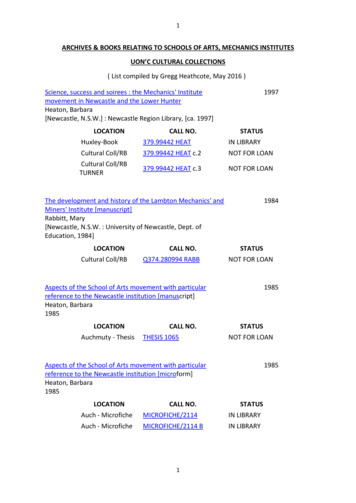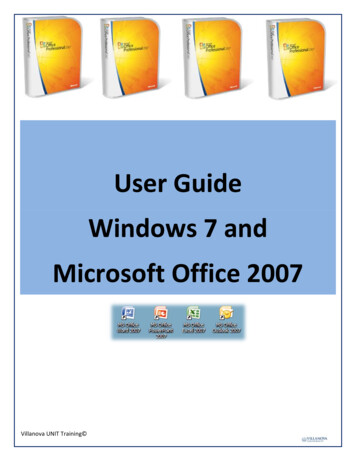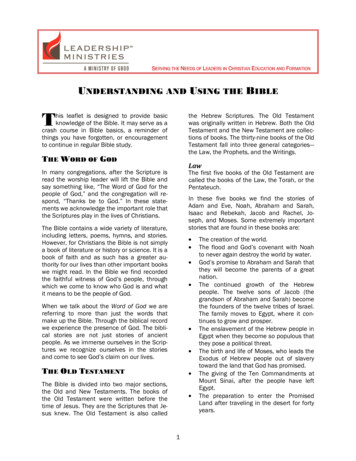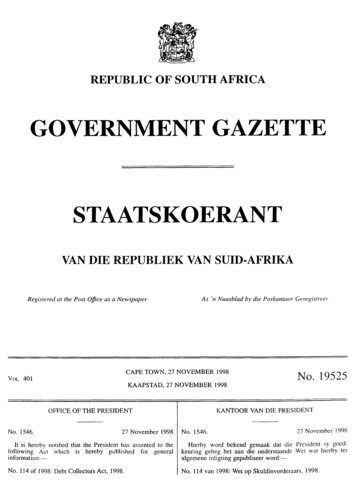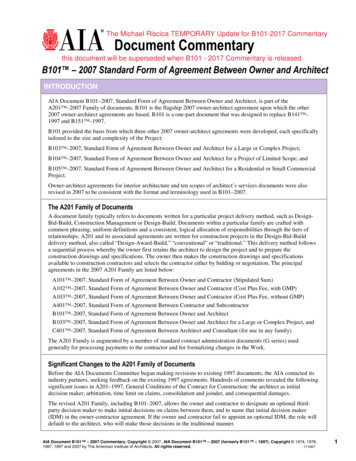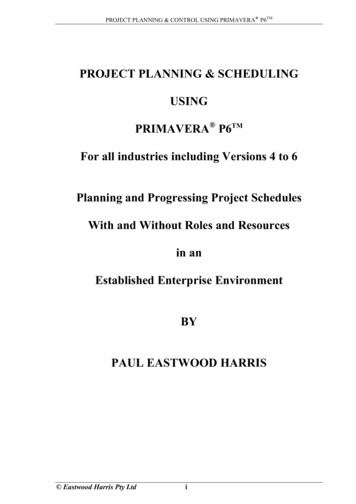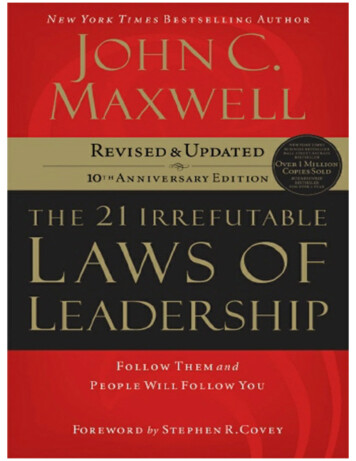
Transcription
1998 and 2007 by John C. MaxwellAll rights reserved. No portion of this book may be reproduced, stored in a retrieval system, or transmitted in any form or byany means—electronic, mechanical, photocopy, recording, scanning, or other—except for brief quotations in critical reviewsor articles, without the prior written permission of the publisher.Published in Nashville, Tennessee, by Thomas Nelson. Thomas Nelson is a trademark of Thomas Nelson, Inc.Thomas Nelson, Inc. titles may be purchased in bulk for educational, business, fund-raising, or sales promotional use. Forinformation, please e-mail SpecialMarkets@ThomasNelson.com.Published in association with Yates & Yates, LLP, Attorneys and Counselors, Orange, California.Scripture quotations noted CEV are from THE CONTEMPORARY ENGLISH VERSION. 1991 by the American Bible Society. Used by permission.Scripture quotations noted The Message are from The Message: The New Testament in Contemporary English. 1993 byEugene H. Peterson.Library of Congress Cataloging-in-Publication DataMaxwell, John C., 1947The 21 irrefutable laws of leadership : follow them and people will follow you / John C.Maxwell. -- 10th anniversary ed.p. cm.Includes new foreword by Stephen Covey and two new appendices.Includes bibliographical references.ISBN 978-0-7852-8837-4 (repak)ISBN 978-0-7852-8935-7 (IE)1. Leadership. 2. Industrial management. I. Title. II. Title: Twenty one irrefutable laws of leadership.HD57.7.M3937 2007658.4'092--dc222007018067Printed in the United States of America07 08 09 10 11 QW 9 8 7 6 5 4 3 2 1
This book is dedicated to Charlie Wetzel, my writing partner since 1994. Together we’vewritten more than forty books, and I’ve enjoyed our collaboration on every one. As I havelabored to add value to others by identifying and teaching leadership principles, Charlie, youhave added value to me and my efforts. Your insights and skills as a wordsmith have beenenjoyed by millions of readers. As a result, you have made a greater impact on morepeople than has anyone else in my inner circle. For that I thank you.
CONTENTSForeword by Stephen CoveyAcknowledgmentsIntroduction1. THE LAW OF THE LIDLeadership Ability Determines a Person’s Level of EffectivenessBrothers Dick and Maurice came as close as they could to living the American Dream—without making it. Instead a guy named Ray did it with the company they had founded. Ithappened because they didn’t know the Law of the Lid.2. THE LAW OF INFLUENCEThe True Measure of Leadership Is Influence—Nothing More, Nothing LessAbraham Lincoln started with the rank of captain, but by the time the war was over, he wasa private. What happened? He was a casualty of the Law of Influence.3. THE LAW OF PROCESSLeadership Develops Daily, Not in a DayTheodore Roosevelt helped create a world power, won a Nobel Peace Prize, and becamepresident of the United States. But today you wouldn’t even know his name if he hadn’tknown the Law of Process.4. THE LAW OF NAVIGATIONAnyone Can Steer the Ship, but It Takes a Leader to Chart the CourseUsing a fail-safe compass, Scott led his team of adventurers to the end of the earth—andto inglorious deaths. They would have lived if only he, their leader, had known the Law ofNavigation.5. THE LAW OF ADDITIONLeaders Add Value by Serving OthersWhat kind of a Fortune 500 CEO works on a folding table, answers his own phone, visitshourly employees as often as possible, and is criticized by Wall Street for being too good tohis employees? The kind of leader who understands the Law of Addition.6. THE LAW OF SOLID GROUND
Trust Is the Foundation of LeadershipIf only Robert McNamara had known the Law of Solid Ground, the war in Vietnam—andeverything that happened at home because of it—might have turned out differently.7. THE LAW OF RESPECTPeople Naturally Follow Leaders Stronger Than ThemselvesThe odds were stacked against her in just about every possible way, but thousands andthousands of people called her their leader. Why? Because they could not escape thepower of the Law of Respect.8. THE LAW OF INTUITIONLeaders Evaluate Everything with a Leadership BiasHow does Steve Jobs keep reinventing Apple Computer and taking it to the next level? Theanswer can be found in the Law of Intuition.9. THE LAW OF MAGNETISMWho You Are Is Who You AttractHow did the Confederate army—understaffed and underequipped—stand up so long to thepowerful Union army? The Confederates had better generals. Why did they have bettergenerals? The Law of Magnetism makes it clear.10. THE LAW OF CONNECTIONLeaders Touch a Heart Before They Ask for a HandAs the new leader, John knew that the most influential person in the organization couldtorpedo his leadership. So what did he do? He reached out using the Law of Connection.11. THE LAW OF THE INNER CIRCLEA Leader’s Potential Is Determined by Those Closest to HimLance Armstrong is hailed as the greatest cyclist who ever lived. People credit histoughness. They credit his brutal training. What they miss is the Law of the Inner Circle.12. THE LAW OF EMPOWERMENTOnly Secure Leaders Give Power to OthersHenry Ford is considered an icon of American business for revolutionizing the automobileindustry. So what caused him to stumble so badly that his son feared Ford Motor Companywould go out of business? He was held captive by the Law of Empowerment.13. THE LAW OF THE PICTURE
People Do What People SeeEasy Company withstood the German advance at the Battle of the Bulge and dashedHitler’s last hope for stopping the Allies’ advance. They were able to do it because theirleaders embraced the Law of the Picture.14. THE LAW OF BUY-INPeople Buy into the Leader,Then the VisionThey freed their nation by passively protesting, even when it cost them their lives by thethousands. What would inspire them to do such a thing? The Law of Buy-In.15. THE LAW OF VICTORYLeaders Find a Way for the Team to WinWhat saved England from the Blitz, broke apartheid’s back in South Africa, and won theChicago Bulls multiple world championships? In all three cases the answer is the same.Their leaders lived by the Law of Victory.16. THE LAW OF THE BIG MOMomentum Is a Leader’s Best FriendThe two-minute film was meant to show off the power of the company’s animationtechnology. What it did was engage the power of the Big Mo— leading to billions of dollarsin revenue.17. THE LAW OF PRIORITIESLeaders Understand That Activity Is Not Necessarily AccomplishmentThey called him the wizard. His priorities were so focused that if you give him a date andtime, he can tell you exactly what drill his players were performing and why! It won him tenchampionships. What can the Law of Priorities do for you?18. THE LAW OF SACRIFICEA Leader Must Give Up to Go UpWhat would you give up for the people who follow you? This leader gave his life. Why?Because he understood the power of the Law of Sacrifice.19. THE LAW OF TIMINGWhen to Lead Is As Important As What to Do and Where to GoLeaders at every level dropped the ball: the mayor, the governor, the cabinet secretary, andthe president. Not one of them understood the potential devastation that can come when aleader violates the Law of Timing.
20. THE LAW OF EXPLOSIVE GROWTHTo Add Growth, Lead Followers—To Multiply, Lead LeadersIs it possible to train more than a million people around the globe? It is if you use leader’smath. That’s the secret of the Law of Explosive Growth.21. THE LAW OF LEGACYA Leader’s Lasting Value Is Measured by SuccessionWhat will people say at your funeral? The things they say tomorrow depend on how you livetoday using the Law of Legacy.ConclusionAppendix A: 21 Laws Leadership EvaluationAppendix B: 21 Laws Growth GuideNotesAn Excerpt from Leadership Gold
FOREWORDBy Stephen R. CoveyWhen John Maxwell asked me to write the foreword for this 10th anniversary edition of The21 Irrefutable Laws of Leadership, I was honored and intrigued. During the past twodecades, John and I have traveled on parallel paths in our speaking and writing. We haveboth been called “leadership experts” over the years. We know and respect each other’swork. But in spite of the similarities between our messages, we have rarely spoken to thesame audience.So to recommend this book allows me to introduce John Maxwell and his teaching tomembers of my audience who have not yet read him. And what better book to recommendthan this new and improved version of The 21 Irrefutable Laws of Leadership? It serves asa sort of manifesto for his teaching and his life. Study this book and you have gotten toknow John Maxwell the person as well as his philosophy of leadership.When The 21 Laws was first published in 1998, I could see immediately how practicaland applicable the laws were. They still are. For over three decades, John Maxwell hasearned his reputation as a communicator. And as he says, communicators “make thecomplex simple.” Rather than an esoteric examination of leadership, this book is more like afoundational instruction manual. With each chapter, you will get to know individuals who did—or some who didn’t—obey the law in question. The law itself is defined clearly and simply.And—most importantly—John will give you specific steps for applying it to the leadership inyour office, community, family, or church.John has told me regarding this revision that he was excited about the opportunity toinclude the lessons he has learned since The 21 Laws was first written. I know what hemeans. Leadership is not static, and neither should be books about it. I believe this revisededition will have an even greater impact than its predecessor. Laws have been updated,illustrations refined, and applications enhanced. The foundational leadership concepts havenot been abandoned; rather, they have been updated for a new generation of leaders. Asgood as the original was, this new edition is even better.If The 21 Irrefutable Laws of Leadership is new to you, let me say that you are in for atreat. It will change the way you live and lead. As you read, you will be encouraged andyour ability to lead will expand. If you have read the original book, then you will be thrilledwith this new edition. You will learn many new lessons as well as being reminded of truthsthat will serve you well. And by engaging in the new application activities, you will reallysharpen your skills.
I trust that you will enjoy and benefit from reading this book, just as I did. In it you will findabsolutely amazing, inspiring leadership stories!STEPHEN R. COVEYauthor of The 7 Habits of Highly Effective People,The 8th Habit, and Everyday Greatness
ACKNOWLEDGMENTSThank you to the thousands of leaders around the world who learned and sometimeschallenged the laws of leadership, thus sharpening my thinking.Thank you to the team at Thomas Nelson who gave me the chance to revise and improvethis book, and especially to Tami Heim for her strategic leadership and to Victor Oliver whowas instrumental in the development of the original concept.Thank you to Linda Eggers, my executive assistant, and her assistant, Sue Caldwell, fortheir incredible service and willingness to go the extra mile every day.Thank you to Charlie Wetzel, my writer, and Stephanie, his wife, with-out whose work thisbook would not have been possible.
INTRODUCTIONEvery book is a conversation between the author and the individual reading it. Some peoplepick up a book hoping for a bit of encouragement. Some devour a book’s information as ifthey were attending an intensive seminar. Others find in its pages a mentor they can meetwith on a daily, weekly, or monthly basis.The thing I love about writing books is that it allows me to “talk” to many people I willnever personally meet. That’s why I made the decision in 1977 to become an author. I hada passion to add value to people that energized me to write. That passion still burns withinme today. Few things are more rewarding to me than being on the road and havingsomeone I’ve never met approach me to say, “Thank you. Your books have really helpedme.” It’s why I write—and intend to continue writing!Despite the deep satisfaction of knowing that my books help people, there is also a greatfrustration that comes with being an author. Once a book is published, it freezes in time. Ifyou and I knew each other person-ally and we met weekly or monthly to talk aboutleadership, every time we got together I’d share with you something new I’d learned. As aperson, I continue to grow. I’m constantly reading. I’m analyzing my mistakes. I’m talking toexcellent leaders to learn from them. Each time you and I were to sit down, I’d say, “Youwon’t believe what I just learned.”As a conference and event speaker, I often teach the principles I write about in mybooks, and I’m constantly updating my material. I use new stories. I refine ideas. And Ioften gain new insights as I stand in front of an audience. However, when I go back tobooks that I’ve previously writ-ten, first, I become aware of how I’ve changed since I’vewritten them. But second, I become frustrated because the books can’t grow and changealong with me.That’s why I got excited when my publisher, Thomas Nelson, asked if I would like torevise The 21 Irrefutable Laws of Leadership for a special tenth anniversary edition. When Ioriginally wrote the book, it was my answer to the question, “If you were to take everythingyou’ve learned about leadership over the years and boil it down into a short list, what wouldit be?” I put on paper the essentials of leadership, communicated as simply and clearly aspossible. And soon after the book was published and it appeared on four differentbestseller lists, I realized it had the potential to help a lot of people become better leaders.GROWTH CHANGEBut now, years later, there are things I am no longer satisfied with in the original edition,and I knew I could improve upon some of the ideas. Some stories had become dated, and I
wanted to replace them with new ones. I had also developed new material to better explainand illustrate some of the principles. While teaching the laws for nearly a decade in dozensof countries around the world, I fielded thousands of questions about them. That processadvanced my thinking beyond what it was when I first wrote the book. Working on this tenthanniversary edition has allowed me to make those improvements.By far the biggest change I wanted to make to the original book centered on two of thelaws. What? you may ask. How can you change one of your irrefutable laws?First of all, while teaching them I soon discovered that two of the laws were really justsubsets of other laws. The Law of E. F. Hutton (When the Real Leader Speaks, PeopleListen) was really just an aspect of the Law of Influence (The True Measure of LeadershipIs Influence—Nothing More, Nothing Less). When people around a table stop and listen to aleader speak, they are revealing that the speaker has influence. Because the ideas in theLaw of E. F. Hutton were part of the Law of Influence, I merged those two chapters.Similarly, I recognized that the Law of Reproduction (It Takes a Leader to Raise Up aLeader) was assumed in the Law of Explosive Growth (To Add Growth, Lead Followers—To Multiply, Lead Leaders). For that reason, I combined them as well.The other thing that happened was that I began to realize that I had missed some thingswhen writing about the laws of leadership originally. I discovered the first omission as soonas I had taught the laws a few times in developing countries. I found that in many of thoseplaces, leadership was focused on position, privilege, and power. In my paradigm ofleadership, I took some things for granted. I see leadership primarily as a form of serviceand had never identified a law to teach that principle. The second oversight had to do withmodeling leadership and impacting the culture of an organization. The result is the inclusionof two new laws in this tenth anniversary edition of The 21 Irrefutable Laws of Leadership:The Law of Addition: Leaders Add Value by Serving OthersThe Law of the Picture: People Do What People SeeFrom today’s perspective I ask myself, How could I have missed them? But I did. Thegood news is that you won’t! I feel certain that these two laws will add immeasurably to thebook and to your ability to lead. Serving others and showing others the way are two criticalcomponents of successful leadership. I wish I could revise each of my books every tenyears to include things I missed!MORE LESSONS LEARNEDThere are two other things I’ve been reminded of as I’ve taught the 21 Laws these last tenyears:1. LEADERSHIP REQUIRES THE ABILITY TO DO MORE THAN ONE THING WELL
Instinctively, successful people understand that focus is important to achievement. Butleadership is very complex. During a break at a conference where I was teaching the 21Laws, a young college student came up to me and said, “I know you are teaching 21 Lawsof Leadership, but I want to get to the bottom line.” With intensity, he raised his index fingerand asked, “What is the one thing I need to know about leadership?”Trying to match his intensity, I raised my index finger and answered, “The one thing youneed to know about leadership is that there is more than one thing you need to know aboutleadership!” To lead well, we must do 21 things well.2. NO ONE DOES ALL 21 LAWS WELLDespite the fact that we must do 21 things well to be excellent leaders, it is reality that noneof us does all of them well. For example, I am average or below average in five of the laws—and I wrote the book! So what is a leader to do? Ignore those laws? No, develop aleadership team.At the end of this book there is a leadership evaluation. I encourage you to take it toevaluate your aptitude for each law. Once you’ve discovered in which laws you are averageor below, begin looking for team members whose skills are strong where yours are weak.They will complement you and vice versa, and the whole team will benefit. That will make itpossible for you to develop an all-star leadership team. Remember, none of us is as smartas all of us.SOME THINGS NEVER CHANGEThough I have made adjustments to the laws and updated the ways I teach them, somethings have not changed in the last ten years. It’s still true that leadership is leadership, nomatter where you go or what you do. Times change. Technology marches forward. Culturesdiffer from place to place. But the principles of leadership are constant—whether you’relooking at the citizens of ancient Greece, the Hebrews in the Old Testament, the armies ofthe modern world, the leaders in the international community, the pastors in local churches,or the businesspeople of today’s global economy. Leadership principles are unchanging andstand the test of time.As you read the following chapters, I’d like you to keep in mind four ideas:1. The laws can be learned. Some are easier to understand and apply than others, butevery one of them can be acquired.2. The laws can stand alone. Each law complements all the others, but you don’t needone in order to learn another.3. The laws carry consequences with them. Apply the laws, and people will follow you.
Violate or ignore them, and you will not be able to lead others.4. These laws are the foundation of leadership. Once you learn the principles, you haveto practice them and apply them to your life.Whether you are a follower who is just beginning to discover the impact of leadership or anatural leader who already has followers, you can become a better leader. As you readabout the laws, you may recognize that you already practice some of them very effectively.Other laws may expose weaknesses you didn’t know you had. Use your review as alearning experieence. In this edition, I’ve included exercises at the end of each chapter tohelp you apply each law to your life.No matter where you are in the leadership process, know this: the greater the number oflaws you learn, the better leader you will become. Each law is like a tool, ready to bepicked up and used to help you achieve your dreams and add value to other people. Pick upeven one, and you will become a better leader. Learn them all, and people will gladly followyou.Now, let’s open the toolbox together.
1THE LAW OF THE LIDLeadership Ability Determinesa Person’s Level of EffectivenessI often open my leadership conferences by explaining the Law of the Lid because it helpspeople understand the value of leadership. If you can get a handle on this law, you will seethe incredible impact of leadership on every aspect of life. So here it is: leadership ability isthe lid that determines a person’s level of effectiveness. The lower an individual’s ability tolead, the lower the lid on his potential. The higher the individual’s ability to lead, the higherthe lid on his potential. To give you an example, if your leadership rates an 8, then youreffectiveness can never be greater than a 7. If your leadership is only a 4, then youreffectiveness will be no higher than a 3. Your leadership ability—for better or for worse—always determines your effectiveness and the potential impact of your organization.Let me tell you a story that illustrates the Law of the Lid. In 1930, two young brothersnamed Dick and Maurice moved from New Hampshire to California in search of theAmerican Dream. They had just gotten out of high school, and they saw few opportunitiesback home. So they headed straight for Hollywood where they eventually found jobs on amovie studio set.After a while, their entrepreneurial spirit and interest in the entertainment industryprompted them to open a theater in Glendale, a town about five miles northeast ofHollywood. But despite all their efforts, the brothers just couldn’t make the businessprofitable. In the four years they ran the theater, they weren’t able to consistently generateenough money to pay the one hundred dollars a month rent that their landlord required.A NEW OPPORTUNITYThe brothers’ desire for success was strong, so they kept looking for better businessopportunities. In 1937, they finally struck on something that worked. They opened a smalldrive-in restaurant in Pasadena, located just east of Glendale. People in Southern Californiahad become very dependent on their cars, and the culture was changing to accommodatethat, including its businesses.The drive-in restaurant was a phenomenon that sprang up in the early thirties, and it was
becoming very popular. Rather than being invited into a dining room to eat, customers woulddrive into a parking lot around a small restaurant, place their orders with carhops, andreceive their food on trays right in their cars. The food was served on china plates completewith glassware and metal utensils. It was a timely idea in a society that was becomingfaster paced and increasingly mobile.Dick and Maurice’s tiny drive-in restaurant was a great success, and in 1940, theydecided to move the operation to San Bernardino, a working-class boomtown fifty mileseast of Los Angeles. They built a larger facility and expanded their menu from hot dogs,fries, and shakes to include barbecued beef and pork sandwiches, hamburgers, and otheritems. Their business exploded. Annual sales reached 200,000, and the brothers foundthemselves splitting 50,000 in profits every year—a sum that put them in the town’sfinancial elite.In 1948, their intuition told them that times were changing, and they made modificationsto their restaurant business. They eliminated the carhops and started serving only walk-upcustomers. And they also stream-lined everything. They reduced their menu and focused onselling ham-burgers. They eliminated plates, glassware, and metal utensils, switching topaper and plastic products instead. They reduced their costs and lowered the prices theycharged customers. They also created what they called the Speedy Service System. Theirkitchen became like an assembly line, where each employee focused on service withspeed. The brothers’ goal was to fill each customer’s order in thirty seconds or less. Andthey succeeded. By the mid-1950s, annual revenue hit 350,000, and by then, Dick andMaurice split net profits of about 100,000 each year.Who were these brothers? Back in those days, you could have found out by driving totheir small restaurant on the corner of Fourteenth and E Streets in San Bernardino. On thefront of the small octagonal building hung a neon sign that said simply McDonald’sHamburgers. Dick and Maurice McDonald had hit the great American jackpot, and the rest,as they say, is history, right? Wrong. The McDonalds never went any further because theirweak leadership put a lid on their ability to succeed.THE STORY BEHIND THE STORYIt’s true that the McDonald brothers were financially secure. Theirs was one of the mostprofitable restaurant enterprises in the country, and they felt that they had a hard timespending all the money they made. Their genius was in customer service and kitchenorganization. That talent led to the creation of a new system of food and beverage service.In fact, their talent was so widely known in food service circles that people started writingthem and visiting from all over the country to learn more about their methods. At one point,they received as many as three hundred calls and letters every month.That led them to the idea of marketing the McDonald’s concept. The idea of franchising
restaurants wasn’t new. It had been around for several decades. To the McDonald brothers,it looked like a way to make money without having to open another restaurant themselves.In 1952, they got started, but their effort was a dismal failure. The reason was simple. Theylacked the leadership necessary to make a larger enterprise effective. Dick and Mauricewere good single-restaurant owners. They understood how to run a business, make theirsystems efficient, cut costs, and increase profits. They were efficient managers. But theywere not leaders. Their thinking patterns clamped a lid down on what they could do andbecome. At the height of their success, Dick and Maurice found themselves smack-dabagainst the Law of the Lid.THE BROTHERS PARTNER WITH A LEADERIn 1954, the brothers hooked up with a man named Ray Kroc, who was a leader. Kroc hadbeen running a small company he founded, which sold machines for making milk shakes. Heknew about McDonald’s. The restaurant was one of his best customers. And as soon as hevisited the store, he had a vision for its potential. In his mind he could see the restaurantgoing nationwide in hundreds of markets. He soon struck a deal with Dick and Maurice, andin 1955, he formed McDonald’s Systems, Inc. (later called the McDonald’s Corporation).Kroc immediately bought the rights to a franchise so that he could use it as a model andprototype. He would use it to sell other franchises. Then he began to assemble a team andbuild an organization to make McDonald’s a nationwide entity. He recruited and hired thesharpest people he could find, and as his team grew in size and ability, his peopledeveloped additional recruits with leadership skill.In the early years, Kroc sacrificed a lot. Though he was in his mid-fifties, he worked longhours just as he had when he first got started in business thirty years earlier. He eliminatedmany frills at home, including his country club membership, which he later said added tenstrokes to his golf game. During his first eight years with McDonald’s, he took no salary. Notonly that, but he personally borrowed money from the bank and against his life insurance tohelp cover the salaries of a few key leaders he wanted on the team. His sacrifice and hisleadership paid off. In 1961, for the sum of 2.7 million, Kroc bought the exclusive rights toMcDonald’s from the brothers, and he proceeded to turn it into an American institution andglobal entity. The “lid” in the life and leadership of Ray Kroc was obviously much higher thanthat of his predecessors.In the years that Dick and Maurice McDonald had attempted to franchise their foodservice system, they managed to sell the concept to just fifteen buyers, only ten of whomactually opened restaurants. And even in that size enterprise, their limited leadership andvision were hindrances. For example, when their first franchisee, Neil Fox of Phoenix, toldthe brothers that he wanted to call his restaurant McDonald’s, Dick’s response was, “What . . for? McDonald’s means nothing in Phoenix.”
In contrast, the leadership lid in Ray Kroc’s life was sky high. Between 1955 and 1959,Kroc succeeded in opening 100 restaurants. Four years after that, there were 500McDonald’s. Today the company has opened more than 31,000 restaurants in 119countries.1 Leadership ability—or more specifically the lack of leadership ability—was thelid on the McDonald brothers’ effectiveness.SUCCESS WITHOUT LEADERSHIPI believe that success is within the reach of just about everyone. But I also believe thatpersonal success without leadership ability brings only limited effectiveness. Withoutleadership ability, a person’s impact is only a fraction of what it could be with goodleadership. The higher you want to climb, the more you need leadership. The greater theimpact you want to make, the greater your influence needs to be. Whatever you willaccomplish is restricted by your ability to lead others.The higher you want to climb, the more you need leadership. The greater the impact you want to make, the greater yourinfluence needs to be.Let me give you a picture of what I mean. Let’s say that when it comes to success,you’re an 8 (on a scale from 1 to 10). That’s pretty good. I think it would be safe to say thatthe McDonald brothers were in that range. But let’s also say that leadership isn’t even onyour radar. You don’t care about it, and you make no effort to develop as a leader. You’refunctioning as a 1. Your level of effectiveness would look like this:SUCCESS WITHOUT LEADERSHIPTo increase your level of effectiveness, you have a couple of choices. You could workvery hard to increase your dedication to
know John Maxwell the person as well as his philosophy of leadership. When The 21 Laws was first published in 1998, I could see immediately how practical and applicable the laws were. They still are. For over three decades, John Maxwell has earned his reputation as a communicator.
